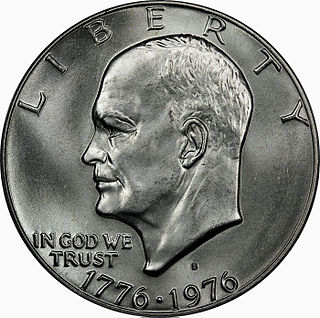
The United States Bicentennial coinage is a set of circulating commemorative coins, consisting of a quarter, half dollar and dollar struck by the United States Mint in 1975 and 1976. Regardless of when struck, each coin bears the double date 1776–1976 on the normal obverses for the Washington quarter, Kennedy half dollar and Eisenhower dollar. No coins dated 1975 of any of the three denominations were minted.

The Eisenhower dollar was a one-dollar coin issued by the United States Mint from 1971 to 1978; it was the first coin of that denomination issued by the Mint since the Peace dollar series ended in 1935. The coin depicts President Dwight D. Eisenhower on the obverse, and on the reverse a stylized image honoring the 1969 Apollo 11 Moon mission based on the mission patch designed by astronaut Michael Collins. Both sides were designed by Frank Gasparro. It is the only large-size U.S. dollar coin whose circulation strikes contained no silver.
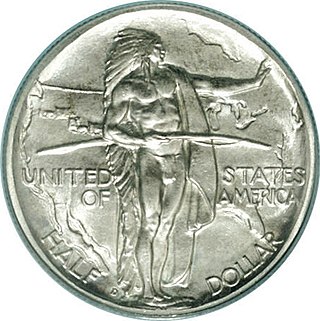
The Oregon Trail Memorial half dollar was a fifty-cent piece struck intermittently by the United States Bureau of the Mint between 1926 and 1939. The coin was designed by Laura Gardin Fraser and James Earle Fraser, and commemorates those who traveled the Oregon Trail and settled the Pacific Coast of the United States in the mid-19th century. Struck over a lengthy period in small numbers per year, the many varieties produced came to be considered a ripoff by coin collectors, and led to the end, for the time, of the commemorative coin series.
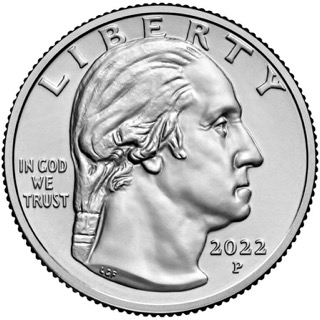
The Washington quarter is the present quarter dollar or 25-cent piece issued by the United States Mint. The coin was first struck in 1932; the original version was designed by sculptor John Flanagan.

The Bridgeport, Connecticut, Centennial half dollar is a commemorative fifty-cent piece issued in 1936 by the United States Bureau of the Mint to honor the 100th anniversary of the incorporation of Bridgeport, Connecticut, as a city. Designed by Henry Kreis, the obverse depicts the showman P. T. Barnum, who was one of Bridgeport's most famous residents, was mayor of the city, helped develop it, and is buried there. The reverse depicts a stylized eagle.

The New Rochelle 250th Anniversary half dollar is a commemorative coin struck by the United States Bureau of the Mint to mark the 250th anniversary of the settling of New Rochelle in Westchester County, New York. Artist Gertrude K. Lathrop designed the piece; she was chosen after work by Lorrilard Wise was rejected by the federal Commission of Fine Arts (CFA). The coin depicts a fatted calf on one side, being led by John Pell, who sold the land on which New Rochelle now stands; the other shows a fleur de lis, an element of the city seal of New Rochelle and of France's La Rochelle, its eponym. The piece is dated 1938 but was minted the previous year. The New Rochelle piece was the last new-design commemorative struck by the Mint until 1946.

The Elgin, Illinois, Centennial half dollar was a fifty-cent commemorative coin issued by the United States Bureau of the Mint in 1936, part of the wave of commemoratives authorized by Congress and struck that year. Intended to commemorate the centennial of the founding of Elgin, the piece was designed by local sculptor Trygve Rovelstad. The obverse depicts an idealized head of a pioneer man. The reverse shows a grouping of pioneers, and is based upon a sculptural group that Rovelstad hoped to build as a memorial to those who settled Illinois, but which was not erected in his lifetime.
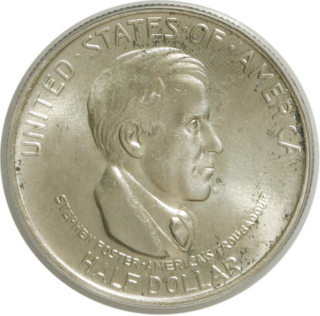
The Cincinnati Musical Center half dollar or Cincinnati Music Center half dollar is a commemorative 50-cent piece struck by the United States Bureau of the Mint in 1936. Produced with the stated purpose of commemorating the fiftieth anniversary of Cincinnati, Ohio, as a center of music, it was conceived by Thomas G. Melish, a coin enthusiast who controlled the group which was allowed to buy the entire issue from the government, and who resold the pieces at high prices.

The five Panama–Pacific commemorative coins were produced in connection with the 1915 Panama–Pacific International Exposition in San Francisco. Struck at that city's mint, the issue included round and octagonal $50 pieces. Excepting modern bullion coins, these two gold pieces are the highest denomination ever issued and the largest coins ever struck by the United States Mint. The octagonal $50 piece is the only U.S. coin to be issued that is not round.

The Missouri Centennial half dollar is a commemorative fifty-cent piece struck by the United States Mint in 1921. It was designed by Robert Ingersoll Aitken. The US state of Missouri wanted a commemorative coin to mark its centennial that year. Legislation for such a coin passed through Congress without opposition and was signed by President Warren G. Harding on his inauguration day, March 4, 1921. The federal Commission of Fine Arts hired Aitken to design the coin, which depicted Daniel Boone on both sides. The reverse design, showing Boone with a Native American, has been interpreted as symbolizing the displacement of the Indians by white settlers.
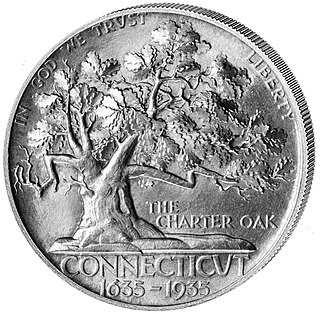
The Connecticut Tercentenary half dollar, sometimes called the Connecticut half dollar, is a commemorative 50-cent piece struck by the United States Bureau of the Mint in 1935. The coin was designed by Henry Kreis and commemorates the 300th anniversary of the founding of Connecticut. Its obverse depicts the Charter Oak, where according to legend Connecticut's charter was hidden to save it from being confiscated by the English governor-general. An eagle appears on the coin's reverse side.

The Hudson, New York, Sesquicentennial half dollar, sometimes called the Hudson Sesquicentennial half dollar, is a commemorative fifty-cent piece struck by the United States Bureau of the Mint in 1935. The coin was designed by Chester Beach. Its obverse depicts the Half Moon, flagship of Henry Hudson, after whom the city of Hudson, New York is named. In addition to showing the ship, the coin displays a version of the Hudson city seal, with Neptune riding a whale, a design that has drawn commentary over the years.
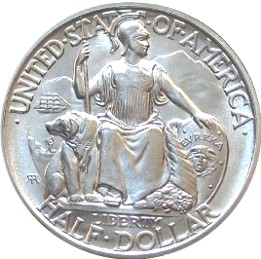
The California Pacific International Exposition half dollar, sometimes called the California Pacific half dollar or the San Diego half dollar, is a commemorative fifty-cent piece struck by the United States Bureau of the Mint in 1935 and 1936. Robert I. Aitken designed the coin. Its obverse depicts Minerva and other elements of the Seal of California; the reverse shows buildings from the California Pacific International Exposition, which the coin was issued to honor.

The Old Spanish Trail half dollar is a commemorative coin struck by the United States Bureau of the Mint in 1935. The coin was designed by L. W. Hoffecker, a coin dealer, who also was in charge of its distribution.
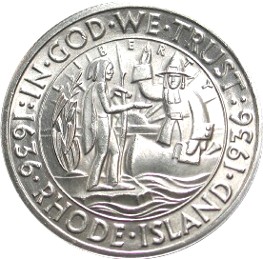
The Rhode Island Tercentenary half dollar is a commemorative fifty-cent piece struck by the United States Bureau of the Mint in 1936. The coin was designed by John Howard Benson and Arthur Graham Carey. Its obverse depicts Roger Williams, founder of the Colony of Rhode Island and Providence Plantations. It was intended to honor the 300th anniversary of Providence, Rhode Island, although it bears no mention of the city.

The Wisconsin Territorial Centennial half dollar was a commemorative half dollar designed by David Parsons and Benjamin Hawkins and minted by the United States Bureau of the Mint in 1936. The obverse depicts a pick axe and lead ore, referring to the lead mining in early Wisconsin, while the reverse depicts a badger and the territorial seal.

The York County, Maine, Tercentenary half dollar is a 50-cent commemorative coin minted in 1936 to mark the tercentenary of the founding of York County, Maine. The obverse shows Brown's Garrison, the fort around which York County was formed, while the reverse depicts the county's arms.

The Delaware Tercentenary half dollar is a commemorative fifty-cent piece struck by the United States Bureau of the Mint to commemorate the 300th anniversary of the first successful European settlement in Delaware. The obverse features the Swedish ship Kalmar Nyckel, which brought early settlers to Delaware, and the reverse depicts Old Swedes Church, claimed to be the oldest Protestant church in the United States still in use as a place of worship. While the coins are dated "1936" on the obverse and the reverse also has the dual date of "1638" and "1938", the coins were actually struck in 1937.

The Roanoke Island, North Carolina, half dollar is a commemorative coin issued by the United States Bureau of the Mint in 1937. The coin commemorated the 350th anniversary of the Roanoke Colony, depicting Sir Walter Raleigh on one side, and Eleanor Dare on the other, holding her child, Virginia Dare, the first child of English descent born in an English colony in the Americas.





















